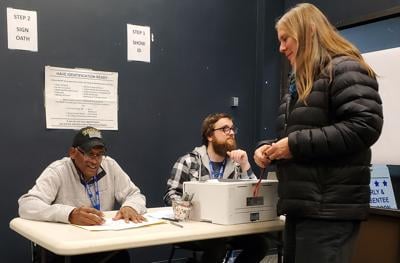An ordinance authorizing the hand counting of two voter precincts after municipal elections will go before the Fairbanks North Star Borough Assembly on Thursday.
Assemblymember David Guttenberg sponsored the ordinance following a lengthy debate and a failed vote on whether to renew a contract with Dominion Voting Systems. That vote resulted in a 4-4 deadlock after nearly 30 residents spoke out against the contract.
One of the key issues discussed was whether the borough conducted random hand count audits to detect discrepancies — something Guttenberg believed was already part of the process.
The ordinance would require the election canvassing board to randomly select two contested races from two precincts and conduct hand counts. The hand-counted results would be compared to the Dominion machine tabulations. If discrepancies beyond a certain margin are found, the audit would expand.
“We’re not doing the whole precinct or all the races, but it should give us enough of an understanding of accuracy,” Guttenberg said at a recent Assembly work session. “All of this is about making sure everything is accurate.”
Ballots for the manual audit would be drawn from the borough’s 32 voting precincts and the early voting station.
Although Guttenberg has strongly defended the accuracy of Dominion’s vote-tabulating machines and rejected widely debunked conspiracy theories about them being hackable, he views the hand-count audit as a reasonable verification step.
Failure to approve a five-year contract does not eliminate the requirement that municipal elections use optical scan machines unless the borough code is amended. The borough still has the option of entering into annual service contracts, which are less costly than a long-term agreement.
The proposed ordinance would apply only to the borough’s October municipal elections and not to Alaska’s statewide or presidential elections.
Borough Clerk April Trickey said she would likely assign three canvassing board members to conduct the hand count on the Wednesday following the election. She estimated the audit would take one day and cost approximately $500, barring an expanded audit due to a discrepancy.
The audit will expand if any discrepancy exceeds 1%.
Two precincts will be drawn from a bucket, and a second bucket will contain all contested races. Contested races include any with at least two non-write-in candidates, as well as ballot propositions.
Ballots will be sorted by candidate — A, B, C (if applicable), write-ins, blanks (unmarked ovals or overvotes). The audit team will follow the same rules used in official recounts to determine if a ballot is valid.
“We have rules that we are required in code to provide to voters in the booth,” Trickey said. “They are given instructions on how to fill in the oval... they are the same rules adopted by the state Division of Elections when they do a recount.”
Hand-counted results will be compared to Dominion machine tabulations to verify accuracy.
Trickey noted that the borough’s voting machines undergo rigorous testing before elections. A security seal is placed over the network port compartment, and the machines are transported to polling sites while not connected to any phone lines or cellular modems.
Any broken seal must be reported immediately. After polls close, the results are transmitted to the clerk’s office via secure, multi-layered text message.
“We have an audit process in place that, before any transmission, we print the tape results from the machine,” she said. “Those tape results are looked at by our canvass board after the election and compared to the tabulated printed results.”
Discrepancies such as half-filled ovals or marks made with red ink are counted during normal processing, as long as voter intent is clear.
Unlike a recount, which seeks to interpret voter intent (e.g., circling a candidate’s name without filling the oval), the audit’s purpose is to confirm machine accuracy.
Objections and opportunity
The proposed ordinance received both support and opposition when it was introduced at the April 10 Assembly meeting.
“The community spoke very loudly in opposition to renewing the Dominion contract,” said North Pole resident Don Thompson. “If the machines are used, they will be used without Dominion support, warranty or software.”
Thompson claimed Georgia and Wisconsin found “definite corruption errors wherein they can be hacked or manipulated by outside sources.”
Georgia election officials, however, have consistently defended the integrity of their voting system. Following the 2024 presidential election, the state conducted an audit of 5.3 million ballots and found just 87 discrepancies.
On April 1, a U.S. District Court judge dismissed a long-running lawsuit seeking to block the use of Georgia’s voting machines. Unlike Georgia, which uses touchscreen machines, the Fairbanks North Star Borough and other Alaska municipalities still use paper ballots, which are scanned optically.
Valerie Therrien, a veteran election official with 20 years of experience, said borough election workers count ballots after machine tabulation to ensure the correct total.
“Not only do we calculate the number of ballots, we also count the number of ballots ripped up because they were done wrong,” Therrien said. Voters who incorrectly fill out a ballot may request a replacement.
“I feel there is not a lot of fraud going on in the elections in the borough and state,” she said, adding that Guttenberg’s ordinance might help counter perceptions of fraud among some community members.
The Assembly will hold a public hearing on the ordinance Thursday night. The meeting begins at 6 p.m. at the Juanita Helms Administration Center, 907 Terminal Street. Public hearings on special orders, including ordinances, begin after 7 p.m.

